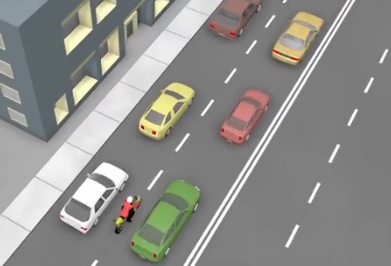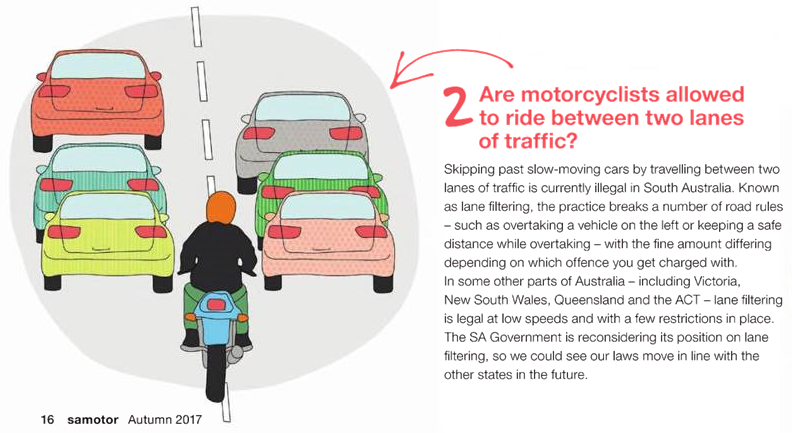 |
The Motorcycle Riders' Association of South Australia |
|
||
|
|
 |
| Lane Filtering - State Matrix | |||||||||||||||||||||||||||||||||||||||||||||||||||||||||||||||||||||||||||||||||||||||||||||||||||||
|
Here is a table outlining lane filtering abilities in each state, current as at 1 May 2021. | |||||||||||||||||||||||||||||||||||||||||||||||||||||||||||||||||||||||||||||||||||||||||||||||||||||
| |||||||||||||||||||||||||||||||||||||||||||||||||||||||||||||||||||||||||||||||||||||||||||||||||||||
|
(1) - can not filter around heavy vehicles, in merging traffic, in reduced speed zones, at roundabouts or in a special purpose lane. (2) - can not filter around heavy vehicles or buses. (3) - Two year trial commenced 1 February 2015 and concluded on 31 January 2017. Following the trial, filtering became legal. (4) - not permitted in bicycle, bus or tram lanes, between vehicles and the kerb, or on roundabouts. (5) - not permitted between the edge of the road and other vehicles. Not permitted next to parked cars. (6) - unique and nationally inconsistent rules for filtering on road shoulders and in emergency lanes (7) - The Motorcycle Safety consultation paper was launched on 23 June 2018, closed 23 July 2018. New legislation effective 29/3/2021. Refer item 130B. | |||||||||||||||||||||||||||||||||||||||||||||||||||||||||||||||||||||||||||||||||||||||||||||||||||||
| Lane Filtering - Background and History | |||||||||||||||||||||||||||||||||||||||||||||||||||||||||||||||||||||||||||||||||||||||||||||||||||||
 Image captured from the NSW Government website | |||||||||||||||||||||||||||||||||||||||||||||||||||||||||||||||||||||||||||||||||||||||||||||||||||||
|
What is Lane Filtering? Lane filtering is the practice of motorcycles moving between stopped or slow-moving cars. This contrasts with riding between fast moving traffic which is termed lane splitting and is illegal. Benefits from lane filtering include reducing the risk of riders being caught up in a rear end collision, and has the potential to help ease traffic congestion. Rear enders are a common collision and can result in a rider being severely injured. The NSW Government Centre for Road Safety has as webpage containing some good information on Lane Filtering. 06 October 2013 Maurice Blackburn and the Australian Motorcycle Council are delighted to release their 'Lane filtering' motorcycle video, designed to promote discussion around this important issue. Lane filtering helps address traffic congestion and is six times safer for motorcyclists. Lane filtering is defined as motorcycles moving between lanes of slow or stationary traffic. Lane filtering is different to the practice of lane splitting (also known white-lining and lane sharing), which is defined as riders moving between lanes of traffic at high speed. Please take a look at this youtube video advocating lane filtering. The SMIDSY facebook page has further information. The Victorian Motorcycle Council have issued the following media release (14th Oct 2013). 4 March 2014 The NSW Government has issued a media release indicating they will introduce a new law (in NSW) that will permit fully licensed motorcyclists to legally filter past stationary and slow-moving vehicles at intersections when it is safe to do so. All indications have the law coming into effect on 1 July 2014. The Motorcycle Council of NSW has released a web page on lane filtering. 27 November 2014 A recent article in the RAA magazine SA Motor had committee member Dr Phil Creer concerned enough to write the RAA to clarify some comments about lane splitting and filtering in South Australia. Phil wrote: "For many years there has been debate re motorcycle lane-splitting/filtering here in SA and the general opinion (including from SAPOL) has been that nowhere in South Australian legislation is there any mention of either legality or illegality of this action so may I ask you to supply me with the relevant legislation that was quoted in the SAMotor magazine recently where it was stated categorically that this action is illegal. We realise that certain actions involved in lane splitting/filtering MAY involve traffic act breeches (lane-change without signaling, crossing white line, passing on left) but specific illegality is - to our knowledge - nowhere mentioned. If you have information to the contrary please supply so that our members may receive correct information." Here is part of the response from Graeme O'Dea, Senior Legal Advisor, RAA Group. "... I apologize that the paragraph on page 19 of the SA Motor does read as if there is a specific offence and the inclusion of a penalty further enhances that false impression. The penalty included in the paragraph is the penalty for breaches of ARR 146 and 147." Click to read the full response from Graeme O'Dea. Update 10 April 2015 Lane filtering was legalised in NSW in July 2014, and in Qld in February 2015. The Australian Capital Territory is currently doing a 2 year trial (2015/2016). Victoria anticipate filtering to be legalised in September 2015. On the 8th April 2015 on ABC radio Melbourne, in an interview with Stephen Bardsley, the acting Chief Commissioner of Victoria Police, Tim Cartwright advised Victoria Police support the introduction of Filtering as a road safety measure. Hear the interview. Update 29 September 2015 Lane filtering was legalised in Victoria today, to come into effect on the 2nd November 2015. View the media release by the Hon Luke Donnellan MP, Minister for Roads and Road Safety, Victoria State Government. View the media release by the VMC. This is a welcomed outcome, the MRASA acknowledges the efforts of Maurice Blackburn Lawyers, The Victorian Motorcycle Council and others. Here is the Victorian Road Rules Amendment for lane filtering 30 September 2015 - Filtering in South Australia Filtering is not legal, nor is it illegal in South Australia. There is currently no road rule either way. The problem for riders, to do it legally in SA, you must pass the cars on the right hand side (driver side) of the lane, use blinkers appropriately, not cross any lines on the road, keep an appropriate amount of clearance and not be considered to be riding in a dangerous or reckless manner. Crossing the solid line at the front of the cars at a red light is an offence as is using push bike lanes. The likelihood of being charged with a traffic offence when filtering is too high for it to be widely practiced. The MRASA has been advocating for legalised filtering and the latest push is through the Motorcycle Reference Group, a stakeholder group associated with DPTI. The politicians simply throw any discussion on it back to DPTI so we believe that is where we need to prove our case. The official state government position is to wait and see for 12 months how the filtering laws work interstate, and then we need to show why SA would benefit from them here. We are currently gathering reports on the interstate filtering and it is looking promising with few hassles. | |||||||||||||||||||||||||||||||||||||||||||||||||||||||||||||||||||||||||||||||||||||||||||||||||||||
| MRASA Position on Lane Filtering in South Australia - August 2016 | |||||||||||||||||||||||||||||||||||||||||||||||||||||||||||||||||||||||||||||||||||||||||||||||||||||
|
The Motorcycle Riders' Association of South Australia fully supports the introduction of lane filtering
legislation in South Australia for the four reasons outlined below. At the same time we categorically
state that we do not endorse the practice of lane splitting. 1. Clarity of responsibility Currently there is no legal prohibition of lane filtering. On this basis motorcyclists are filtering without guidelines causing inconsistencies in behaviour, confusion for road users and therefore increased risk of crashes. By introducing clearly defined legislation all road users will know exactly what their responsibilities are, which behaviours are acceptable and which are prohibited. At the same time clear penalties for incorrect behaviour can be introduced as a punitive measure. 2. Reduce traffic congestion Motorcycles have the ability to move off quickly from a stationary position. Allowing motorcycles to move to the front of a stationary queue will result in more traffic passing through that point than if the motorcycle were to be restricted to remaining in the queue and travelling at the speed of the slowest vehicle. 3. Reduced risk of rear end crashes Any crash involving a motorcycle is potentially more serious for the rider than for car drivers. Lane filtering removes the motorcycle from the stationary position within the traffic queue thereby achieving a crash risk reduction. NSW lane filtering trial crash data also indicated that during the trial period no crashes attributable to filtttering were reported. 4. Standardisation of Road Rules throughout Australia Australia currently has 6 separate jurisdictions each applying variations to road rules. MRASA encourages the adoption of best practice road rules in an effort to achieve commonality across Australia and reduce the risk of misinterpretation and subsequent crashes by road users. Preferred Legislative Model The MRASA has examined the lane filtering legislation as gazetted in both NSW and Victoria. In both instances rule 151 applies. The prime differences noted between the two jurisdictions are as follows. 1a. Filtering is permitted for holders of an unrestricted licence only (NSW) 1b. Filtering is prohibited for holders of learners permits (VIC) 2a. Filtering is prohibited in school zones (NSW) 2b. Filtering in school zones is permitted (VIC) School Zones - Given that the entire basis of lane filtering is 'when safe to do so' the MRASA suggest we adopt legislation which prohibits filtering past schools and also is only permitted by holders of an unrestricted licence. School zones should be restricted because of the unpredictable behaviour of school age children and the increased risk of a crash caused by erratic actions. Licence Level - Filtering requires a degree of bike control and traffic awareness which is acquired over time and experience. Restricted licence holders have not had sufficient time to accumulate this experience hence there is a risk that their assessment of 'when safe to do so' may not be correct. Speed Limit - A final consideration is the actual speed limit applied to filtering. For the sake of standardisation across all jurisdictions MRASA supports the 30kph speed limit adopted by the eastern states. However, we also suggest that all decision makers review all other similar speed limits such as school zones, roadwork zones and stationary emergency vehicles with active warning lights to achieve consistency within and across jurisdictions. The MRASA recommend South Australia adopts the eastern states model with the above mentioned amendments. Ebi Lux - Vice President & Road Safety Officer ReferencesVicroads - Road Rules Summary for Motorcycles Vicroads - Road Safety Road Rules 2009 (PDF) NSW Legislation - Road Rules 2014 NSW Road Transport Legislation 2014 (PDF) | |||||||||||||||||||||||||||||||||||||||||||||||||||||||||||||||||||||||||||||||||||||||||||||||||||||
| Lane Filtering Update - 2 September 2016 | |||||||||||||||||||||||||||||||||||||||||||||||||||||||||||||||||||||||||||||||||||||||||||||||||||||
|
Following our meeting with the Minister for Road Safety, Mr Peter Malinauskas, the MRASA prepared a position paper outlining
our preferred model for motorcycle lane filtering to be introduced into South Australia. This paper is available on this
website (article above) and contains links to legislation as passed in both Victoria and New South Wales. The paper has been submitted to the relevant government departments for consideration and discussion. As a motorcycle advocacy body, the MRASA would like to thank the departments concerned for the opportunity to present and discuss our point of view in this quite complex area. We have welcomed the feedback received and acknowledge the fact that not all points raised can or will be included in the final draft legislation presented to parliament. As a state based body we will continue to represent motorcyclists at the highest level with absolute integrity at all times. As a member of the Australian Motorcycle Council we continue to represent our concerns at the Federal level to maximise legislative uniformity across all states. We now look forward to the presentation of the draft legislation to parliament within the next few months and congratulate in anticipation the ministers responsible for taking this decisive action. The MRASA reminds members and followers that it is now, and will remain, illegal to filter using bicycle lanes. This is a highly dangerous practice which cannot and will not be supported by the authorities and responsible riders. Ebi Lux - Vice President & Road Safety Officer | |||||||||||||||||||||||||||||||||||||||||||||||||||||||||||||||||||||||||||||||||||||||||||||||||||||
| Lane Filtering Update - 17 September 2016 (amended) | |||||||||||||||||||||||||||||||||||||||||||||||||||||||||||||||||||||||||||||||||||||||||||||||||||||
The table below shows the various aspects of the lane filtering legislation under consideration by the
authorities. Green highlighted boxes indicate interstate conditions being considered by SA. Motorcycle Reference Group Meeting - Report by Ebi Lux, MRASA Road Safety Officer The motorcycle reference group meeting held on 17 November 2016 had three agenda items for discussion.
DPTI then presented its position on interstate filtering conditions which it is considering to present for legislative sign off. Apart from restrictions on R-date licence holders being allowed to filter the proposal is in line with the MRASA published position. Like the MRASA, DPTI see the advantage of trying to implement uniform legislation across the nation. (Table shown above). The MRASA asked for a clearer definition of the vague term 'when safe to do so'. Our thoughts were that as this is a subjective term it is open to interpretation by different officers. DPTI and SAPOL both stated that it was almost impossible to define, examples of safe and unsafe behaviour will be included in the extensive planned education programme which will be released with lane filtering legislation. The licensing proposal has been on the agenda for some time and will continue there for a while yet. The contentious issue were whether the minimum age at which a licence can be obtained should be raised in line with the age for getting a car licence; should the r-date period be extended and what format of instruction should be undertaken by moped riders. The Rider Safety Handbook was a simple case of updating photos to keep the book current. Neville Gray had spent a lot of time updating wording and legislation which had changed since its last revision. The meeting closed on time and as per usual a lot of networking occurred. On a very positive note DPTI confirmed that our position paper was simple, implementable and acceptable. Our influence is evident in the approach now being taken to close off this matter. | |||||||||||||||||||||||||||||||||||||||||||||||||||||||||||||||||||||||||||||||||||||||||||||||||||||
| Lane Filtering Update - 21 February 2017 | |||||||||||||||||||||||||||||||||||||||||||||||||||||||||||||||||||||||||||||||||||||||||||||||||||||
The RAA have published an item on motorcycle lane filtering in their Autumn 2017 edition of the SA Motor
magazine. In the community section under the heading of '10 road-rule questions you've always wanted
answered', question 2 is about current lane filtering laws. Filtering riders in SA are to be mindful
of undertaking this practice given the RAA have informed their readers it is illegal. | |||||||||||||||||||||||||||||||||||||||||||||||||||||||||||||||||||||||||||||||||||||||||||||||||||||
| Lane Filtering Legislation Announced - 22 March 2017 | |||||||||||||||||||||||||||||||||||||||||||||||||||||||||||||||||||||||||||||||||||||||||||||||||||||
|
Minister Malinauskas MLC has announced that lane filtering will be legal in South Australia as from the
15th April 2017. The Department of Planning Transport and Infrastructure has launched a video and will be running
an educational campaign to help all road users understand the new laws. The Motorcycle Riders' Association welcome the introduction of lane filtering for motorcycles. This is the culmination of a lot of hard work over many years by many groups and individuals. We thank the minister for introducting legislation which will improve road safety for motorcyle riders. We now encourage all road users to understand the changes to the SA Road Rules. Below is a copy of the News Release from Peter Malinauskas on 22 March 2017. DPTI has launched a video and will be running an educational campaign to help all road users understand the new laws. The video and information on the new laws are available from the mylicence.sa.gov.au website.  Below is a portion of the Government Gazette (published Tuesday 21 March 2017) outlining the new clause 11C added to the road rules (Gazette pages 932 to 938). The gazette also outlines states a rider of a motor bike engaging in unlawful lane filting will incur a $363 expiation notice.  Image captured from the SA Government gazette  Image captured from the SA Government website | |||||||||||||||||||||||||||||||||||||||||||||||||||||||||||||||||||||||||||||||||||||||||||||||||||||
|